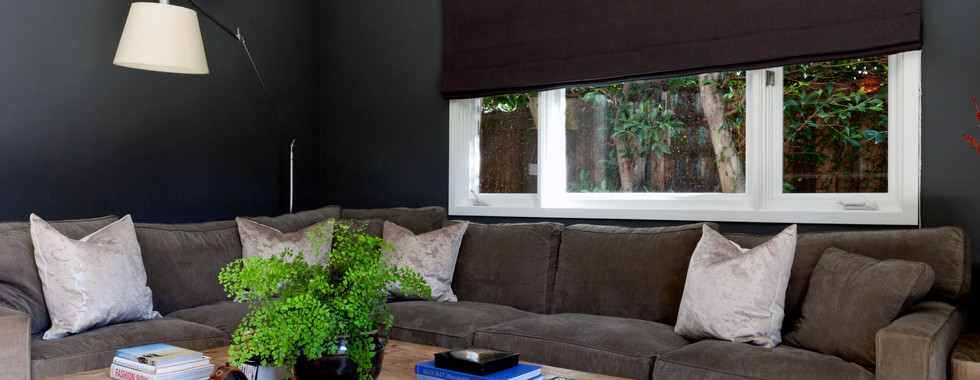EVERYTHING you need to know about Window Treatments
- Lucie Ayres
- Jan 19, 2021
- 4 min read
Window treatments can make or break the design and functionality of your space, but with so many options to choose from, figuring out what you want or need can be overwhelming. Hiring a designer to tackle this process for you will certainly help ease this burden, but it is still useful to have an understanding of the option out there to help you determine what style you prefer upfront and allow you to have an informed conversation with your designer or window treatment vendor.
To help get you started, we have created a guide that breaks down the options for window treatments available, along with our tried-and-true tips on finding the right look for your home.

1. Start With Function
Before you begin to consider colors, textures, or styles, it's best to start with the functional needs for your space. Each room has different needs when it comes to privacy, lighting, aesthetics and accessibility. Determining what these needs are for each room will allow you to narrow down your options for the covering’s style. Think about them amount of light the room gets, how hot the room can get, privacy at night, and what you physically have room for.
Draperies are wonderful for large windows and doors and we love them for rooms facing the street (they look prettier from the outdoors). They are also our go-to for bedrooms because they soften a room and work really well if you need blackout lining.
Roman Shades are our next go to but work better for windows that have furniture in front of them- like the photo below - or rooms that lack space.

2. Choose a Style
And now for the fun part! Style selection includes the way your treatment hangs on the window, its material and color. While you don’t need to select the same treatment for every room, you will want to make sure all the selections flow together to tell one story. As designers, we typically achieve this by selecting materials and colors that not only look good in the individual room’s design, but relate to each other throughout the house. For example, we could select all the treatments to share the same type of fabrication but in different colors per room, or you could go with a singular color but select different styles of treatments. Here are the four most common style of treatments - draperies and roman shades are our go-to.
Shutters work well frankly only in large rooms and vacation homes - shutters are perfect for beach houses and in our opinion don't work well in most other spaces. Even with the slats open they block out 30% of light which is another reason we don't love using them. They are also a hard material and in many rooms we want more fabric to help with acoustics and aesthetics- to balance out the hard surfaces of many rooms.
Blinds are also not our favorite. We prefer a regular shade for above an active kitchen sink or in rooms that require a simple solution.

3. How Will it Hang?
When it comes to drapes and shades, the hardware and how it hangs is one of the most overlooked, yet arguably more crucial aspects that affects the finished look. There are a large variety of pleats and drapery rods that achieve different results. When deciding on finishes and styles of your hardware, we recommend choosing a neutral metal rod- we often use matte black and finials that are more understated like the glass ones in the photo below. The type of pleat you choose will affect the amount of fabric you need. We prefer an X pleat for contemporary homes and a pinch pleat for more formality.
For roman shades, we go for flat folded roman shades - keeping it simple and less fussy is our mantra for all things window treatments.
Hanging Drapes

Hanging Shades

4. More Options
Some spaces require more innovative solutions. One of those is a top down bottom up shade which works beautifully for spaces that need to block out the bottom half of a window because of the view or for privacy but keep the top part open for light and views.
Top Down Bottom Up Shades
Top down bottom up shades can be raised from the bottom or lowered from the top so that you can stack your window covering in any position. This is ideal if you want full light and an unobstructed view, while maintaining privacy.
Valences & Cornice Boxes
Valances and Cornice Boxes are a form of window treatment that covers the uppermost part of the window, jutting out a bit from the wall and concealing drapery hardware. They are a popular choice for traditional homes and can add depth and dimension to your wall.
Electric Shades & Drapes
Adding technology to your window treatments offer many advantages to a modern home. These shades and drapes can be operated via remote or smart device, allowing you to set a schedule for the movement of your treatments, access windows that are normally out of reach and even adjust them when you're away from home. This can be especially helpful in protecting your art and furniture from sun exposure when the light is at it's peak, and even act as a security measure when you're on vacation.
For more tips and tricks on window treatments, check out our reels on Instagram:
Thank you all for reading!
- Lucie and team at 22 Interiors




























































Comments